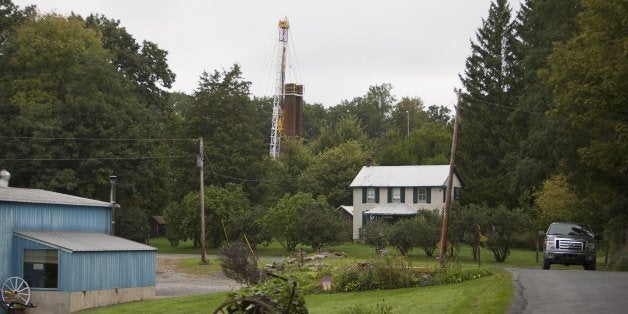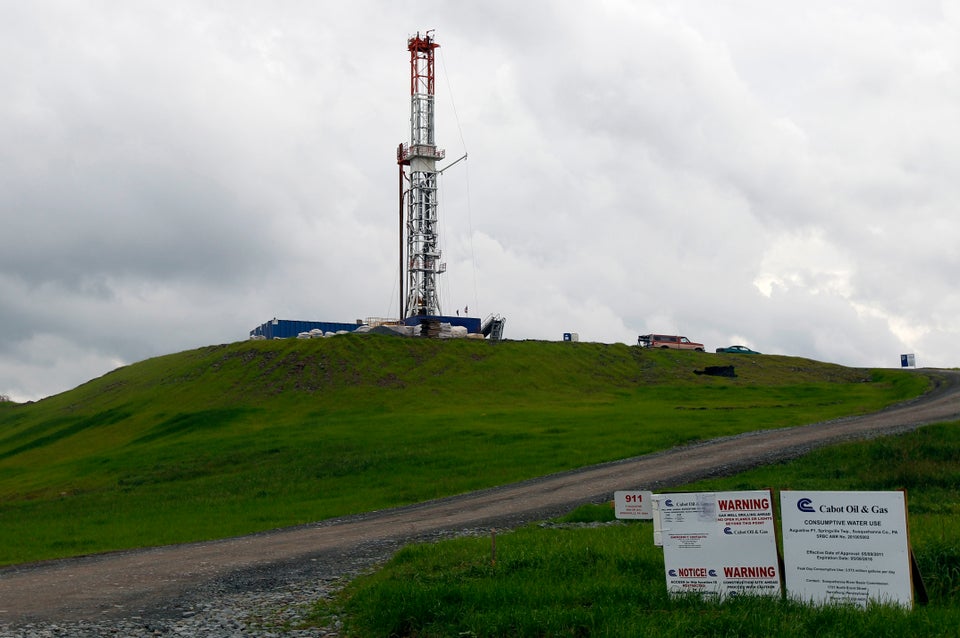
April Lane's work often brings her to Fayetteville, Arkansas, where she monitors pollution from natural gas production sites around the area's rich shale reserves. Exposure to toxins, she says, have left her with chronic headaches, nausea and a hesitancy to have more children.
"I've decided having another baby is probably not going to happen for me. I'm too scared of what the health effects might be," said Lane, 28, of Little Rock, a mother of one and an environmental health advocate who has led citizen groups in tracking threats from hydraulic fracturing, or fracking, operations.
A paper published Friday in Reviews on Environmental Health may give credence to her personal suspicions. The paper suggests that even tiny doses of benzene, toluene and other chemicals released during the various phases of oil and natural gas production, including fracking, could pose serious health risks -- especially to developing fetuses, babies and young children.
"We hear a lot of anecdotal stories all the time," said Dr. Sheila Bushkin-Bedient, of the Institute for Health and the Environment at University at Albany-SUNY and co-author on the paper, "but now that we've had a decade of opportunity to observe the ill effects from these chemicals on people and animals, the evidence is no longer just anecdotal."
The boom in the extraction of oil and natural gas continues across large swaths of the U.S., but not without resistance. Many environmental groups oppose fracking -- which uses a mix of pressurized water, sand and chemicals to unlock hydrocarbon reserves in shale rock -- even as the industry maintains that processes like fracking are safe.
A small Texas town near the birthplace of the fracking boom is the latest case in point: In November voters approved a ban on the practice, due in part to concerns about air and water contamination.
Still, more than 15 million Americans now live within one mile of such oil and gas operations.
The research paper pulls together findings from studies that have investigated links between exposures to chemicals associated with fracking -- and, in some cases, proximity to fracking operations -- and developmental and reproductive problems in animals and humans, including reduced semen quality and increased risk of miscarriage, birth defects and infertility. While the report doesn't provide any new data, the authors say the compilation builds a more compelling case for such connections.
Among the more than 750 chemicals known to be used in fracking, at least 130 may carry the potential to mess with the natural hormone messengers responsible for critical processes such as sleep, metabolism, growth and reproduction. Even in very small concentrations -- say, a couple tablespoons in an Olympic-sized swimming pool -- these endocrine disruptors have been shown capable of derailing normal brain and sexual development, diminishing the immune system's ability to fight disease, and other effects. These could be subtle, experts warn, but the life-long consequences could be profound.
Endocrine disruptors have made headlines in the last few years, as scientists increasingly tie exposures to the chemicals -- which commonly lace plastics, herbicides, non-stick fry pans and other consumer goods -- with potential harms such as obesity, diabetes and breast cancer.
But it has been the acute, more obvious health concerns that have drawn the most attention in the fracking debate. A study published in September, for example, found that people who lived close to fracking sites in southwestern Pennsylvania were more likely to suffer skin and respiratory symptoms compared to those who lived further away. Another study conducted in Arkansas, Colorado, Pennsylvania and Wyoming, and published in October, warned of wells releasing cancer-causing chemicals at levels several-fold greater than federal limits.
Andrea Gore, a professor of pharmacology and toxicology at The University of Texas Austin, suggested that more focus should be directed at the endocrine-disrupting potential of fracking chemicals.
"This is of great concern," she said, adding that she anticipates fracking will prove the next area of study with regard to this class of toxins.
The fracking industry, meanwhile, has criticized the new paper, focusing its censure on a source study by Susan Nagel, an obstetrics and gynecology researcher at the University of Missouri, who is also a co-author of the report. That study, published last December, found more endocrine-disrupting activity in water samples collected near fracking sites in Colorado as compared to sites with no fracking activity.
"The researchers have pushed these same claims before only to receive sharp criticism from Colorado regulators for relying on assumptions that were 'not factually or scientifically valid,'" said Katie Brown, a spokeswoman for Energy in Depth, an industry group. "This report is more of the same. It contains no new data, and (as with their previous report) there is no evidence to make a link between developmental issues and hydraulic fracturing."
The new paper also highlights findings published in March that asserted pregnant women who lived near fracking wells faced an increased risk of having children born with defects such as oral clefts and heart problems. And it further points to science that warns of other chemicals' potential for widespread and long-term harm.
"You're not always going to see an effect straight away," said Sharima Rasanayagam, director of science for the nonprofit Breast Cancer Fund, who was also not involved in the new paper. "Ten, 20, even 50 years down the line there may be health effects which are due to the changes caused in the hormonal systems of developing fetuses."
Rasanayagam underscored another concern shared by health experts and anti-fracking advocates: Fracking companies are not required to disclose all of the chemicals they use in their operations.
A controversial exemption from existing environmental regulations, known as the "Halliburton loophole," continues to make it difficult to monitor, let alone prove any links to health problems, laments Rasanayagam and others.
Katie Huffling, a registered nurse and director of programs with the Alliance of Nurses for Health Environments, added that people are "not just exposed to one chemical by itself, but rather to a chemical soup."
"That can make it a real challenge to tease out what specific chemicals are doing what," said Huffling, who counsels her pregnant patients on avoiding toxins, including endocrine disruptors, in their everyday lives -- from lead in paint to bisphenol-A in plastic products and food can liners.
"We need to be taking a more precautionary approach and protecting the most vulnerable among us," she added.
Nagel acknowledges a "striking need" for more monitoring and research studies to determine just what people living around oil and gas operations are really exposed to, but she maintains there is enough "suggestive" evidence at this point to "cause concern."
Lane in Arkansas, for one, was heartened by the paper. "I've heard countless stories from people dealing with all kinds of health problems," she said. "Now we're finally seeing some evidence backing us up."

